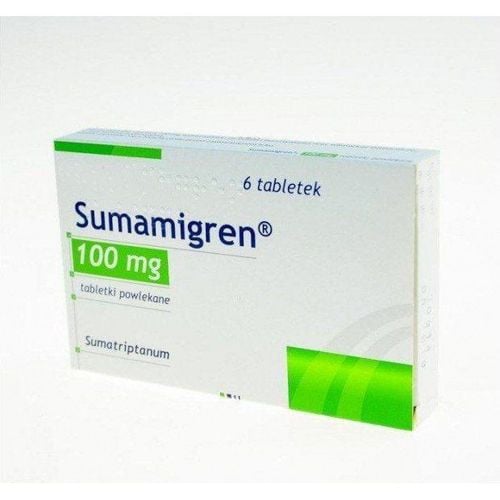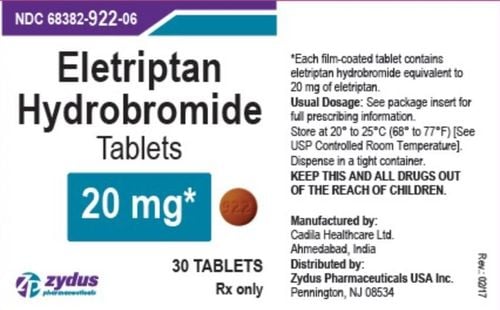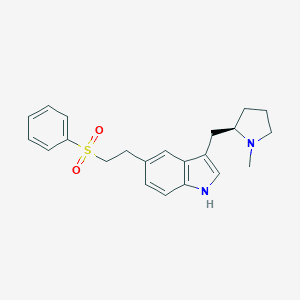This is an automatically translated article.
Sumatriptan is indicated in the treatment of migraine with or without warning symptoms, pain caused by blood vessels in the face,... So how to use Sumatriptan? What precautions should be taken when using this drug? Let's find out the necessary information about the drug Sumatriptan through the article below.
1. What is Sumatriptan?
Generic name (Active ingredient): Sumatriptan Drug type: 5-HT1B, 1D serotonin receptor agonist, anti-migraine. Drug form: Tablets (as Sumatriptan Succinate): 50 - 100 mg. Content: Solution for injection (under Sumatriptan as Sumatriptan Succinate): 12 mg/ml. Nasal spray (spray): 10 - 20 mg/tube. Each tube is equivalent to a single spray of 10mg or 20mg of Sumatriptan.
2. Uses of Sumatriptan
2.1 Indication Sumatriptan is indicated in the following cases:
Treatment of migraine attacks with or without warning symptoms: Nasal spray solution is especially suitable for patients with nausea and vomiting during attacks. Treatment of severe migraine attacks, when other treatments have not worked in previous attacks. Treatment of facial vascular pain (chronic paroxysmal migraine, cluster headache): Use solution for injection. 2.2 Dosage and Administration Dosage:
Adults
Tablets:
The recommended dose is 1 50 mg tablet, which should be taken as soon as possible after the onset of pain, although the drug's effectiveness is effective in any stage of pain. If there is no improvement, a second dose should not be taken in the same episode. Paracetamol, Aspirin or other non-steroidal anti-inflammatory drugs can be used. Sumatriptan can be used for subsequent episodes. If after taking the first pill, the symptoms return, a second tablet may be taken within 24 hours, provided that there is a gap of at least 2 hours between the two doses. A dose of 100 mg may be needed in some patients when the 50 mg dose is not effective. Do not exceed 300 mg/24 hours, keep a minimum gap of 2 hours between 2 doses. Nasal spray solution:
Recommended dose: 1 spray into 1 nostril. An initial dose of 10 mg was effective. If there is no improvement with 10 mg, the next attack can be given a dose of 20 mg. A second dose in the same episode is not recommended. However, this attack can be treated with paracetamol, aspirin or other non-steroidal anti-inflammatory drugs. If improvement is achieved with the first dose but symptoms reappear, a second dose may be given within 24 hours, provided that a minimum interval of 2 hours is ensured between the two doses. Do not use more than 2 sprays in 24 hours. Solution for injection:
For adults over 18 years and under 65 years: Migraine attack: 6 mg subcutaneously as soon as possible. If there is no improvement after the first injection, a second injection in the same episode is not recommended. However, this attack can be treated with paracetamol, aspirin, or other non-steroidal anti-inflammatory drugs. Sumatriptan can be used for later attacks. If there is improvement after the first injection, but symptoms return, a second injection may be given within 24 hours, provided a minimum gap of 2 hours is ensured between the two injections.
Chronic malignant migraine (cluster headache): 6mg subcutaneously for each attack.
Children
Tablets and solution for injection: Children under 18 years of age: Not recommended because safety and efficacy have not been fully studied. Nasal spray solution: Adolescents over 12 years old: Use the same dose as adults. Other population
Elderly: There is limited experience in using Sumatriptan in patients over 65 years of age, and the use of Sumatriptan is not recommended. Patients with hepatic impairment: For patients with mild to moderate hepatic impairment, if treatment is necessary, the maximum single dose should not exceed 50 mg. How to take
Sumatriptan can be taken orally (do not chew, drink with a full glass of water) or injected but should only be administered subcutaneously and should be administered as an injection into the lateral side of the thigh or deltoid muscle. The medicine can also be sprayed into the nose.
2.3 Overdose - Missed dose and management Overdose:
Single doses up to 200 mg (rectally), 40 mg (nasal), over 16 mg subcutaneously and 400 mg orally have no known side effects. notification.
For chronic overdose, available data from postmarketing and long-term treatment suggest that Sumatriptan administered subcutaneously or orally does not require gradual dose escalation or withdrawal symptoms. Sumatriptan should be avoided for prophylaxis.
Treatment:
In case of overdose, monitor the patient for at least 10 hours and treat symptomatically, if necessary. The effect of hemodialysis and peritoneal dialysis on plasma concentrations of Sumatriptan is unknown.
Missed dose and treatment:
If you forget to take a dose, take it as soon as you remember. However, if it is almost time for your next dose, skip the missed dose and take your next dose at the scheduled time. Do not take twice the prescribed dose.
3. Sumatriptan side effects
Common:
Dizziness, somnolence, sensory disturbances (paresthesia, hypoesthesia), transient increase in blood pressure, occurring immediately after treatment, hot flushes, dyspnea, nausea, vomiting (unspecified) determined by disease or medication), a feeling of heaviness (usually transient, but can be severe and occur in any part of the body, including the ribcage and abdomen). Pain, feeling of heat and cold, feeling of oppression. Feeling of muscle weakness, fatigue (these two ADRs are usually mild and transient). Nasal spray: Taste disturbance, temporary mild irritation, burning sensation in the nose and throat, possible nosebleeds. Injection: Pain due to injection site reaction, hot flushes, burning sensation. Rare:
Skin allergies to anaphylaxis, convulsions, seizures with or without history, tremor, dystonia, nystagmus, scoliosis. Visual disturbances, diplopia, decreased visual acuity, vision loss (sometimes permanent), bradycardia, tachycardia, palpitations, arrhythmia, Raynaud's syndrome, hypotension, ischemic colitis localized, stiff neck.
4. Notes when using Sumatriptan
Contraindications
Sumatriptan is contraindicated in the following cases:
Hypersensitivity to one of the components of the drug. History of myocardial infarction or ischemic heart disease, coronary artery spasm (Prinzmetal's angina), peripheral vascular disease. History of cerebrovascular accident or transient ischemic attack. Severe liver failure. Moderate or severe hypertension and mild but uncontrolled hypertension. Not for use in migraine prophylaxis or treatment of hemiplegia or skull base migraine. Do not use together with Ergotamine or its derivatives (including methysergid), MAOIs (see Interactions). Sumatriptan should not be given intravenously because of the risk of coronary artery spasm. Note
When a migraine has not been diagnosed or has been diagnosed but has atypical symptoms, a thorough examination is necessary to rule out other potentially severe neurological conditions. Attention should be paid to migraine patients because there is a high risk of stroke or transient ischemic attack. After taking Sumatriptan, there may be temporary symptoms such as chest pain, a feeling of chest compression spreading to the throat, which makes you think of angina. Do not take additional doses and seek medical attention immediately. Sumatriptan should not be used in patients with suspected ischemic heart disease, including smokers or on nicotine-based substitutes, without prior cardiac examination. Particular attention must be paid to postmenopausal women and men over 40 years of age with risk factors. Serotonin syndrome (changes in mental status, autonomic manifestations and neuromuscular disorders) has occurred but very rarely after co-administration with a selective serotonin reuptake inhibitor and Sumatriptan. Patients must be closely monitored. A 5-HT1-agonist/triptan should not be combined with Sumatriptan. People with a history of seizures because of the possible risk of lowering the seizure threshold. People with liver or kidney failure. People who are sensitive to Sulfamides. Note to pregnant women
Experience with the use of Sumatriptan during pregnancy is limited. Although drug etiology has not been established, there has been one case of failure to develop the corpus callosum (Corpus Callosum) in an infant whose mother received Sumatriptan at 4 and 6 weeks gestation. Sumatriptan should be used during pregnancy only after carefully weighing the potential benefits and risks to the fetus.
Note to nursing women
Sumatriptan is distributed into breast milk. Avoid breast-feeding for 12 hours after the mother has treated, subcutaneously, or nasal spray Sumatriptan.
Precautions while driving and operating machines
No studies on the effects on the ability to drive and use machines have been performed. Drowsiness may occur due to migraine or treatment with Sumatriptan. This may affect the ability to drive and use machines.
5. Drug interactions
Interactions with other drugs
Avoid combining Sumatriptan with any of the following drugs: Ergot derivatives (rye striatum), MAO inhibitors, Sibutramine. Increased efficacy/toxicity: Sumatriptan may increase the concentration/effect of ergot derivatives; Serotonin regulator. Sumatriptan concentration/effect may be increased by ergot derivatives, MAO inhibitors, Sibutramine. Reduced efficacy: It is not known that there are any significant interactions that decrease the potency of Sumatriptan. Food Interactions
Avoid drinking with alcohol, alcohol increases the risk of gastrointestinal bleeding, ulceration and perforation when used with Sumatriptan. Drug interactions can change how a drug works or increase the effect of side effects. This document does not cover all possible drug interactions. Write a list of all the medicines you are taking (including prescription, nonprescription and dietary supplements) and show them to your doctor or pharmacist.
Please dial HOTLINE for more information or register for an appointment HERE. Download MyVinmec app to make appointments faster and to manage your bookings easily.













